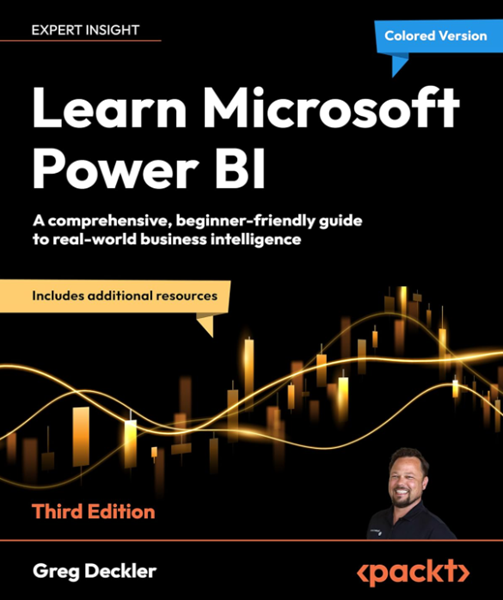Book Review: Learn Microsoft Power BI - Third Edition

My friends at PackT recently sent me a review copy of fellow MVP Greg Deckler’s third edition of Learn Microsoft Power BI . It’s not released yet but is available for pre-order.
Production quality and additional resources
The book is written well and the copy and tech editing seem well handled.
I was particularly impressed to see that Art Tennick was a tech reviewer. I regularly mention Art’s books. I like the way he presents recipe style books. He did it with MDX and again with DAX. Many people don’t want a detailed coverage of a language, just a series of recipes on how to use it. That’s what some of Art’s books provide.
Once again, I like the fact that there is a GitHub repository that you can download the code that’s used in the book from. There’s also a PDF that you can download, that shows all the color images from the book. I know a lot of people appreciate that because screenshots can be hard to read in a book format, even online.
Content
The book is targeted at beginners, and starts by describing why on Earth you might be using these tools in the first place. This is followed by a fairly detailed description of all the common industry tools that are used for BI and, in particular, ETL (or ELT) processing.
Given the timing of it’s release, it’s appropriate that the book provides coverage of the relevant parts of Microsoft Fabric, as well as Power BI.
I understand the desire to cover licensing, as it does confuse many people. My only concern is that, with Microsoft, it can be a pretty fast-moving target. That can make the content in the book out-of-date quickly. Hopefully it will stay stable for a while now but I note that the discussion on PBIRS (Power BI Report Server) and or SSRS, is already out of date, based on the announcements at the recent Build conference. I hope Greg gets to update this before the book is published.
I know that Microsoft keeps doing their best lately to move people off AAS (Azure Analysis Services) because they want everyone on Fabric. But Fabric is far from an obvious licensing choice for people currently using AAS. It might have been worth mentioning it as an option for how a semantic model that’s used by Power BI might be hosted. We have a large number of clients who do just this. AAS is mentioned in the book, but as far as I could tell, only in terms of using it as a data source via the supplied connector. Doing that though, is an anti-pattern.
The book has a really good discussion on how to use the various transformations in Power Query.
One thing I’d like to see spelled out though, is a discussion on the decimal data type really only being a floating point type i.e., an approximation. I have several customers who aren’t happy that Power BI can’t seem to add up numbers accurately. It’s ok for monetary values that can be set for the Currency data type, but it’s super annoying for other decimal values that need to be accurate.
Naming is always a tough topic. I’ll just note that the standards that we use for our semantic models are quite different to what’s presented in the book.
In the DAX related content, I liked seeing _VAR covered, even in this beginner book. It’s a good habit to get into.
The overall appearance of reports is important, so I liked seeing themes being discussed. It helps to provide a corporate look and feel to the reports.
Similar to my point on licensing, I always hesitate to be very specific on the current UI, particularly in the portal. But I understand the need to have this for beginners. Given the constant state of UI churn from Microsoft though, I’m not sure what the right option is here. I’ve seen detailed practice instructions in other content, that are 100% perfect at the time they’re published, yet two weeks later, users couldn’t follow them at all.
I liked the discussion on dashboards. The only comment I’d make is that I see them being used less and less at my clients’ sites.
I noticed that Import and DirectQuery were discussed, but I didn’t see any mention of DirectLake (unless I missed it).
I really liked the discussion around the anarchy model. I’ve seen that far too often at sites who have just done their own thing for any length of time. In addition to my earlier comments on AAS, I would like to have seen some discussion on just connecting to an on-premises Analysis Services server. We still come across many clients who simply don’t want their data in the cloud, yet they are happy to use a cloud-based service like Power BI to just render it.
It was interesting to see a discussion on career paths, etc. at the end of the book. I’ve not seen that mentioned in other books, yet it’s certainly useful for beginners. I loved the coverage of getting noticed. This is critical for getting the best roles.
Summary
Overall, I really enjoyed this book. It’s exactly the right length and provides a good coverage of the topic. Great work Greg !
8 out of 10
2025-07-01
